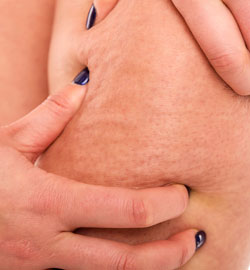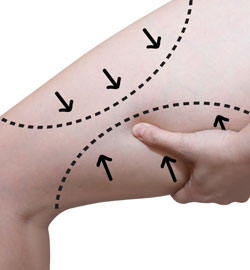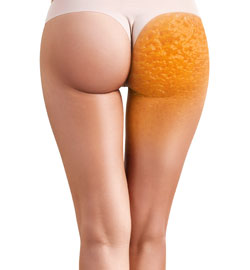


About Cellulitis
Cellulite is made up of normal fat cells trapped in lymphatic liquid and fibrous tissue.
This alteration of the fatty layer under the skin often affects young and older women and manifests itself with an excess of fat in the areas of the thigh, abdomen and hips. In many cases, the height to weight ratio is perfectly normal.
The well-defined, cellulite masses can be painful and can vary in size during the mentrual cycle.
The skin, puckered on the surface, looks like orange peel.
Cellulite can appear in people who are physically very active. Therefore, it is obvious that doctors who treat cellulitis should not consider the ‘calorie intake/calorie burning’ ratio as they would in cases of obesity.
The root of the problem may be found in the imbalance of hormone production: patients with cellulitis complain of irregular menstrual cycles and a period of post-ovulation with symptoms associated with hyperfolliculinia characterized by a weight gain of approximately 2 kg, discomfort, anzxiety, insomnia and pains in the breast and abdomen. These symptoms tend to increase gradually until the end of the menstrual cycle that has a liberating effect.
Cellulitis is often associated with circulatory problems: the legs are tired and aching and standing erect for prolonged periods is painful and, at the end of the day, feet and ankles are swollen.
If these problems are not addressed over the years, circulation becomes difficult causing the appearance of varicose veins.
Liposuction
Liposuction, or the removal of local fat deposits by infiltration and the insertion of tiny cannulas designed to reduce the thickness of the treated area, is at present the most invasive of all procedures. Liposuction is one of the most common surgical procedures performed in general surgery and in cosmetic surgery. In fact a growing number of women submit to liposuction to remodel their body shape.
If carried out correctly, this procedure is not any more dangerous than others and the results are often surprising. Even if it is used to remove localized fat, Liposuction works well where cellulite is well-defined and circumscribed especially when used in association with laser therapy. The technique is not complicated hence the possibility to perform the procedure in Day Hospital.
Advanced knowledge of the fatty layer and of the skin has allowed us to develop micro-cannulae with maximum aspirating strength without creating trauma to surrounding tissue.
During the recovery period, the patient will simply have to wear an elastic body stocking for two weeks.
Cavitation
Among the higher impact cosmetic treatments, there is cavitation, that is the treatment of fatty tissue or cellulitis using low frequency wave-lengths. The process consists in breaking down the fatty cells and stimulating the surrounding tissues to expel liquids.
Cellulitis can be found circling the waist, thighs arms or it can be localized in areas like the base of the buttocks or the inner thighs. Cavitation is ideal for localized and diffused cellulitis.
Mesotherapy
When circulatory disturbances, hormonal problems, emotional stress, sedentary life-style, dietary errors, drug abuse create an accumulation of toxins in the connective tissue, the composition and structure of the tissue itself is modified causing the formation of cellulitis.
Cellulitis has three forms according to the prevaling pathology:
- soft cellulitis (edema)
- hard cellulitis (fibrosis)
- fatty cellulitis (fat cells)
The bio-mesotherapy protocol calls for 10 applications, one per week, and a maintenance regime of one treatment every two months.
In addition, it is also advised to begin a oral treatment to eliminate toxins.
This combination of treatments is aimed at 4 areas:
- circulatory system
- connective tissue massage
- hormonal system
- lipolysis
The various drugs are mixed in one syringe and are combined according to the type of cellulitis the patient presents.
For each group, these are the most common remedies and the most efficient phytotherapies used.
